IBM Rational Host Access Transformation Services (HATS) Fix Pack
V8.0.0.1
Copyright International Business Machines Corporation 2011. All rights reserved. US Government Users Restricted Rights - Use, duplication
or disclosure restricted by GSA ADP Schedule Contract with IBM Corp.
Release notes
This document includes the following information:
This fix pack may be applied to IBM®
Rational® HATS V8.0 installations. For the current list of supported hardware and software prerequisites
for HATS V8.0.0.1, refer to the
Rational Host Access Transformation Services V8.0 - Detailed System Requirements
web page.
For HATS V8.0 documentation, refer to
the
IBM Rational Host Access Transformation Services (HATS) V8.0 Information Center
.
HATS web browser support is extended to Mozilla Firefox Versions 6 and 7. This includes support
for HATS web and portlet applications as well as WebFacing applications.
This extended support enables you to specify the generated package name for RESTful web services.
To specify the package name, from the Rational SDP menu bar, select Window
> Preferences > HATS > Default Java Packages and enter the package name in
the RESTful services field. Changing the package name here does not
rename previously created RESTful services packages.
HATS Dojo widget support is extended to enable you to specify global variables as the source
for setting values.
The following settings are now available for the HATS Combo box and Filtering select Dojo widgets.
- Fill from global variable
- If selected, fill the drop-down list from the specified global variables.
- Global variable containing list values
- Specifies the name of the indexed global variable containing the set
of values. An item for each index in the global variable will be
created in the drop-down list.
- Shared
- HATS local and shared global variables can have the same name.
Select this box if you want to use the shared global variable to
populate the list items. When this box is cleared, the local global
variable is used.
- Global variable containing list captions
- Optional. Specifies the name of the indexed global variable
containing the set of captions. The size of the global variable
specified by this value should be greater than or equal to the size
specified in the preceding setting. The indexes in this indexed
global variable should also match up with the indexes in the
values global variable (so that the actual value and caption shown
to the user are in sync). If this value is not specified, the caption
for each item in the drop-down list will be its value.
Note: After customizing a Dojo widget using the Transform for Dojo
Editing
option, drop-down list items filled from global variables display only at runtime and not during preview.
Using the Extract global variable action for a screen event, you can extend your HATS
screen customizations and combinations to extract and
provide reuse of data from non-text planes of the host screen. You can use this
extra screen information to enhance the graphical user interface you provide with
your HATS applications and thereby provide a more meaningful user experience.
The supported non-text planes are the: Color, Field, Extended Field, DBCS, and Grid planes.
To select the plane to extract, use the Plane to extract
drop-down list in the Add Extract Global Variable
Action wizard on the Select Screen Region panel.
When you select the Extract this region as one string option, the
extracted data is saved in a global variable as a single object in the
form of a 2-dimensional character array.
When you select the Extract this region as a list
of strings option, the data
is extracted as a 2-dimensional character array and broken up into
individual 1-dimensional arrays, each one representing a single extracted row
and stored in an index in the global variable.
Note: For information about the format and contents of the different data planes in the
Host Access Class Library (HACL) presentation space model, see
Host Access Class Library Planes -- Format and Content.
The Field Minus and Field Plus keys are now available on the host terminal keypad for 5250 sessions.
The VT-PF1, VT-PF2, VT-PF3, and VT-PF4 keys are now available on the host terminal and VME keypads for VT sessions.
Two new VT connection properties enable you to force the normal foreground
or background of the VT Host Terminal to selected colors. This might be useful in a case where a VT
application changes a foreground color to match the background color and thus renders
the text unreadable on the Host Terminal.
The settings can be added to the Advanced tab of the
connection editor. The settings, which operate independently of each other, are forceVTNormalForegroundToColor
and forceVTNormalBackgroundToColor.
The format for the setting value is redValue,greenValue,blueValue where the values each range from 0 to 255.
For example, to override the normal foreground color to be white, add this setting to the table of advanced settings:
forceVTNormalForegroundToColor = 255,255,255
These settings only affect the normal foreground and background colors. If any character attributes are set (bold, blink, underline, or reverse) or if any of the ANSI colors are set by the VT application, these settings are ignored.
This fix pack contains fixes for APARs as well as internal fixes.
See the
HATS support page
for a more detailed description of these APARs.
This update includes the following HATS fixes:
IC75535 - Characters sent by the host are English but should be Hebrew.
IC76362 - After updating to HATS 7.5.1 on a bidi system, the cursor is placed in incorrect locations on the host screen.
IC77598 - HATS rich client project not displaying DBCS fields correctly with small font.
IC78098 - Using DBCS host codepage, date fields lose formatting.
IC78149 - Visual Editor converts the macro variable to a zero.
IC78392 - Unable to open a screen capture for an imported BMS file.
This update includes the following IBM WebFacing Tool for IBM i fixes:
IC78151 - The trace level of the Webfacing HSR component cannot be changed.
The following HATS problems were found internally, so there is
no additional information about them on the HATS support page.
40359 - Widget settings incorrect in screen combination.
40643 - PrintButton always renders as a button.
40795 - Widget previews fail if the HATS component contains the German character,
LATIN SMALL LETTER SHARP S (u+00DF).
40820 - DBCS cursor movement issue for "open" fields in web projects.
40822 - In 5250 J and Y type fields in rich client projects, inputting a prohibited character causes HATS to erase other characters.
40824 - In 5250 J and O type fields in rich client projects, inputting DBCS characters before or after SO/SI causes HATS to insert an additional space.
40825 - In 5250 J type fields in rich client projects, inputting an SBCS character causes HATS to insert an additional space or delete a character in the field.
40827 - AutoIME is not enabled for the Dojo Validation text box widget.
40829 - In 3270 G type fields in rich client projects, you cannot input the appropriate number of DBCS characters.
40832 - DBCS default input value not kept in radio button or drop-down widget.
40835 - Incorrect default orientation displayed for table in Model 1 web page in bidirectional projects.
40839 - Incorrect password rendering by the Dojo text box widget (visual)
and incorrect text order in the Dojo grid widget (visual)
on Model 1 web pages in bidirectional projects.
40848 - Macro extract is always in English even if the keyboard layer is Hebrew.
40850 - Incorrect rendering of RTL prompts for RTL fields in Model 1 pages in bidirectional projects.
40854 - Extraneous debug statement written to the Java console during
migration.
40859 - After editting prompts or extracts in the Visual Macro Editor, the macro does not
run in a web service in bidirectional projects.
40864 - Macro recorded with [vt-pf] keys do not play back successfully.
40870 - DBCS mixed value not kept in rich client drop-down widget when SOSI=OFF.
40873 - The text replacement function does not work correctly in a subfile.
40874 - Screen rendering performance fix for HTMLElement's buildTag method.
40885 - NumberFormatException in the Visual Macro Editor when using macro variables.
40887 - There is no option to "Create RESTful Service Files" in HATS
on Rational Application Developer V8.0.3 with only WebSphere Application Server V7
Feature Pack for Web 2.0 and Mobile installed.
40905 - The User-Defined Character (UDC) editor does not launch from a
DBCS connection editor.
IBM Integration Designer V7.5 is supported as a platform for developing HATS applications.
As you read through this document, when you see a mention of Rational or RSDP, the information also applies to your
IBM Integration Designer installation.
Note: IBM Integration Designer does not contain a visual editor for editing rich client transformations.
Use one of the following methods to edit those transformations:
- Use the Java Editor provided by IBM Integration Designer to edit the Java code of the transformations.
- Install an unsupported Visual Editor into
IBM Integration Designer and use it with HATS V8.0 to visually edit the transformations.
If you install the WebSphere Application Server Version 6.1 Feature Pack for Web Services,
you can create HATS web services for the IBM WebSphere Java API for XML-Based web
Services (JAX-WS) runtime.
If you plan to create HATS web services for the JAX-WS runtime, be aware of the following:
- When you generate a test client, the web_service_nameService.java file is created
with a hardcoded, absolute location of the WSDL file.
If you deploy the test client to a different machine, update the file to contain
the correct WSDL file location.
- The WSDL file that you elect to generate for your web service contains a URL
location of the web service.
This URL points to the local host and port.
Update the local host and port in the URL when you deploy the web Service
to another server.
- If you use chained Integration Objects within your HATS web service, it is a stateful
web service.
If you deploy the stateful HATS web service to a cluster, to enable all Integration Objects
in the chain to use the same Telnet connection, do one of the following:
- Create HATS web services from EJB Access Beans.
The HATS EJB is a stateful session EJB, so the EJB client always interacts with the same
HATS EJB instance.
- Use HTTP session management support, following the
directions found in the WebSphere Application Server Information Center.
In addition to setting the BindingProvider.SESSION_MAINTAIN_PROPERTY setting to true,
update your generated web service to obtain the HttpSession object and explicitly
create the session.
One way to update the web service is to add the following @Resource annotation to
web_service_nameDelegate.java:
@Resource
private WebServiceContext wsContext;
Also add the following lines to the first_in_chain_IO_nameProcessWS method:
MessageContext mc = wsContext.getMessageContext();
HttpSession session = ((javax.servlet.http.HttpServletRequest)mc.get(MessageContext.SERVLET_REQUEST)).getSession();
Following are limitations, known problems, and workarounds for this fix
pack:
- When migrating a HATS web project with no associated EAR,
Web Express Logon (WEL) does not function properly.
The WEL configuration information for a web project is kept in its associated EAR project,
and not imported because the associated EAR project is not imported and migrated.
If you import the web and EAR projects into the workspace
and migrate the web project, the associated EAR project is also migrated and the WEL configuration information is not lost.
- On Windows Vista, Certificate Management (Ikeyman) doesn't start if you attempt to use the
Run as administrator option to start the program.
This occurs in two ways:
- You right-click on the Certificate Management icon, and select Run as administrator.
- You specify Run as administrator on the advanced settings for the
Certificate Management icon properties, and double-click the icon to run the program.
You can run Certificate Management without using the Run as administrator option.
-
In bidirectional projects, using Dojo widgets on Model 1 web pages, incorrect results occur when typing in Autopush mode.
For example, if you type abc (in the bidirectional language), switch to the Latin layer, and type _ABC, then the expected
rendering is cba_ABC. However, the actual rendering is _cbaABC. To work around this problem, press the
End key after typing abc. This problem occurs not only for the underscore character, but also for all neutral characters
(including the space character) separating the bidirectional and Latin languages.
This section describes how to install IBM® Rational® Host Access Transformation
Services (HATS) Fix Pack V8.0.0.1, which contains all fixes available since HATS Version V8.0 was first released.
This fix pack is provided as an update and installed using IBM Installation Manager.
The update is generally installed directly from the IBM update server; however you can also choose to download an
archive file that contains the update and then use IBM Installation Manager to perform local installations.
The following sections describe how to install this update.
Installation prerequisites
Update installation instructions
Archive download for local installation instructions
Verifying your installation
HATS project updates
Installing the HATS runtime plug-ins into your rich client
platform
Installation of this fix pack requires the following:
- Any prior level of HATS V8.0 is installed.
- IBM Installation Manager is installed, and it is updated to the latest level.
If either of these requirements is not satisfied, HATS will not appear in the
Update installation instructions selection list.
For more information about HATS prerequisites, refer to the
Rational Host Access Transformation Services V8.0 - Detailed
System Requirements.
Follow the steps below to install the update. You should perform the
installation using the same Windows account that originally installed the Host Access Transformation
Services (HATS) V8.0 product. The account must have administrator
privileges.
To install directly from the IBM update server:
- Start IBM Installation Manager from the Windows Start menu. By default
this is under Start > All Programs > IBM Installation Manager >
IBM Installation Manager.
- From the menu bar, select File > Preferences.
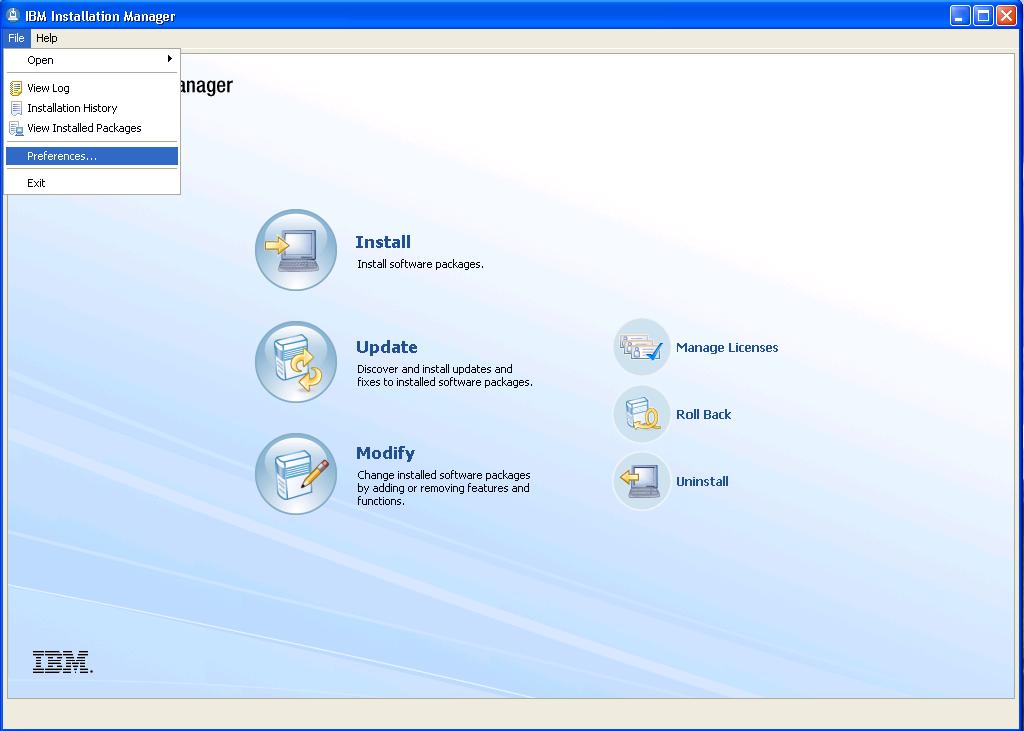
- Ensure that the Search service repositories during installation and
updates. option is selected to allow updates from the IBM Update Server. Click
OK to return to the IBM Installation Manager screen.
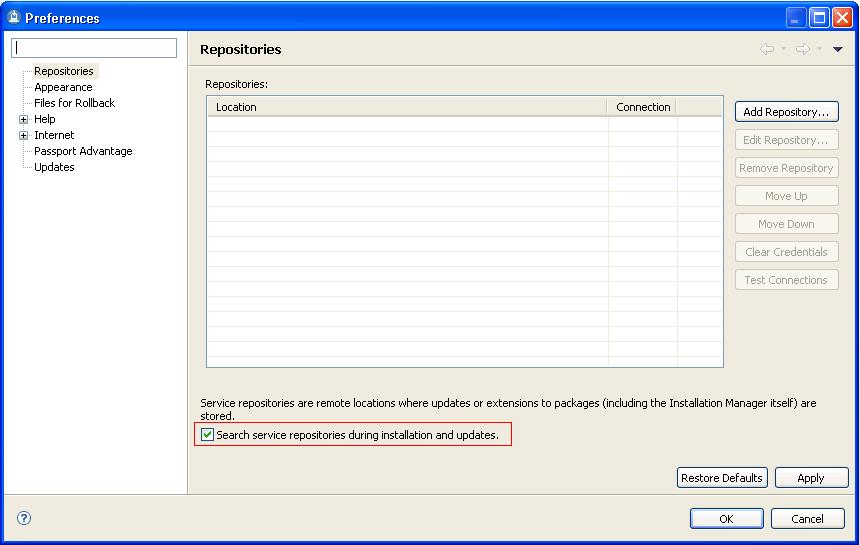
- Click Update.
Note: Do NOT select Install.
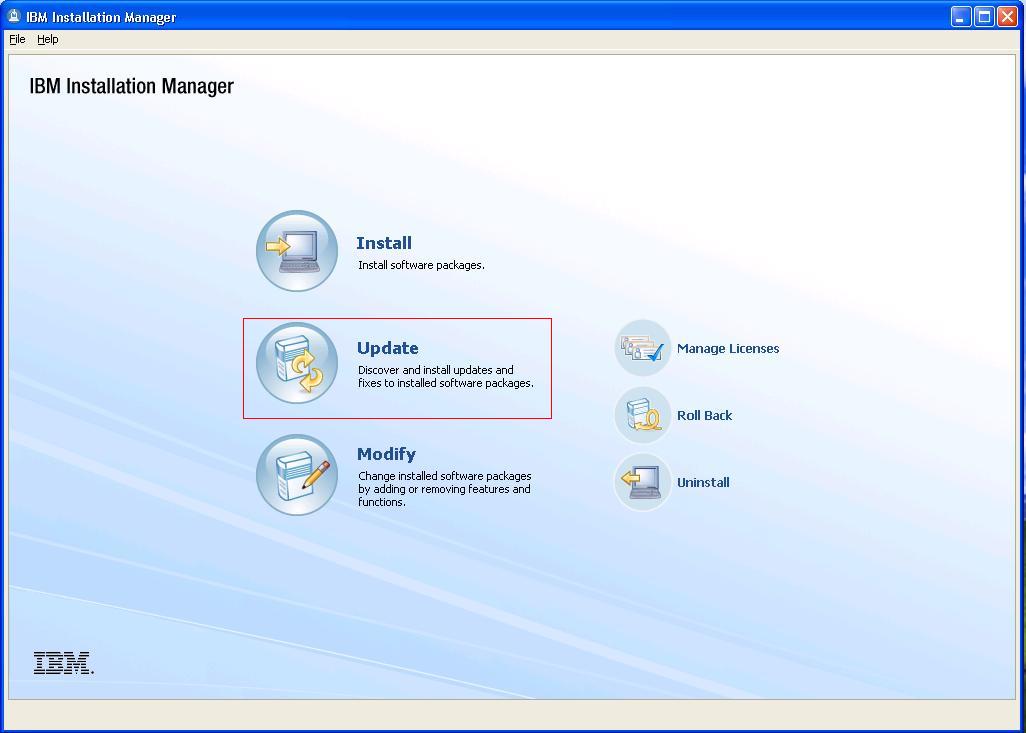
- Select the package group in which you installed IBM Host Access Transformation
Services V8.0. The default is IBM Software Delivery Platform. The
Installed Packages list at the bottom of the panel should show IBM® Rational® HATS
8.0 as one of the entries.
Click Next.
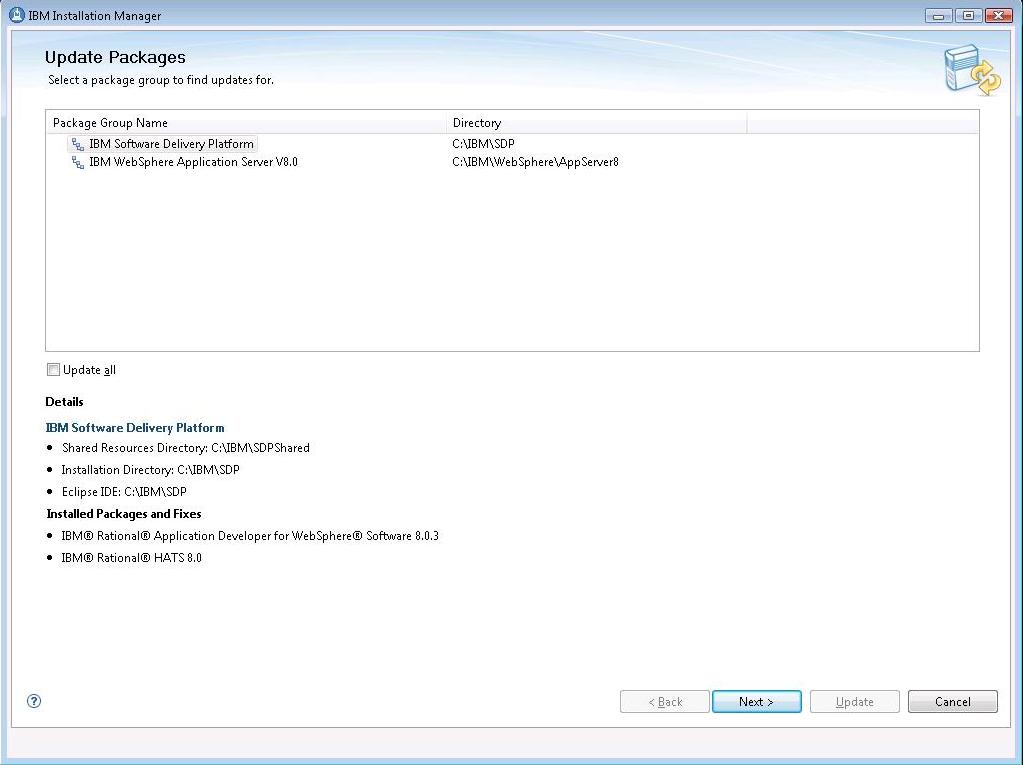
- Select IBM® Rational® HATS 8.0 and Version 8.0.0.1 and any
other required or optional updates from the list of available updates. Any
updates you already have installed will be displayed in grey and will not be
selectable. Click Next.
Note: The Repository will not be as displayed but will indicate the IBM Update Server.
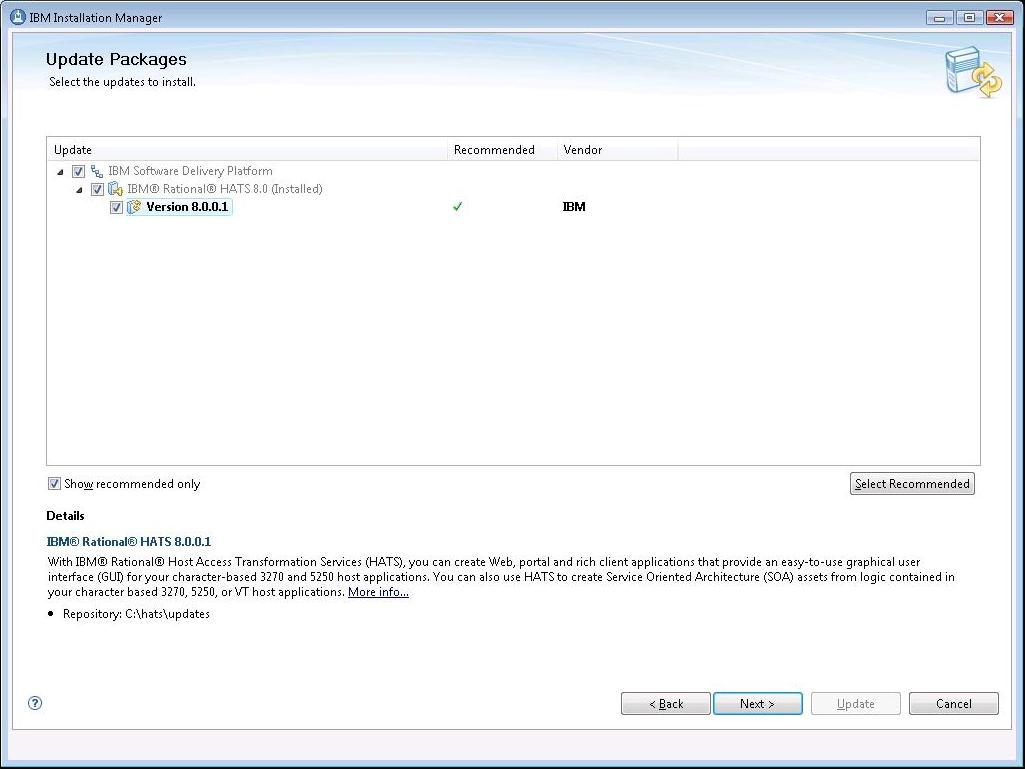
- Read and accept the license agreements for the selected updates, and then
follow the remaining installation dialogs to install the selected
updates.
Note: Depending on the speed of your computer
processor, the amount of RAM, and the speed of your Internet connection, the
update(s) could take an extended period of time to download and install.
- Review your selections on the Summary panel. If you want to make any
changes to your selections, click Back and make your changes. When you
are ready to install the update, click Update.
- When the updates are complete, a message will be displayed by IBM
Installation Manager informing you that updates were successfully installed.
You can click View Log File to view the log file for the current
Installation Manager session. When you are finished, click
Finish.
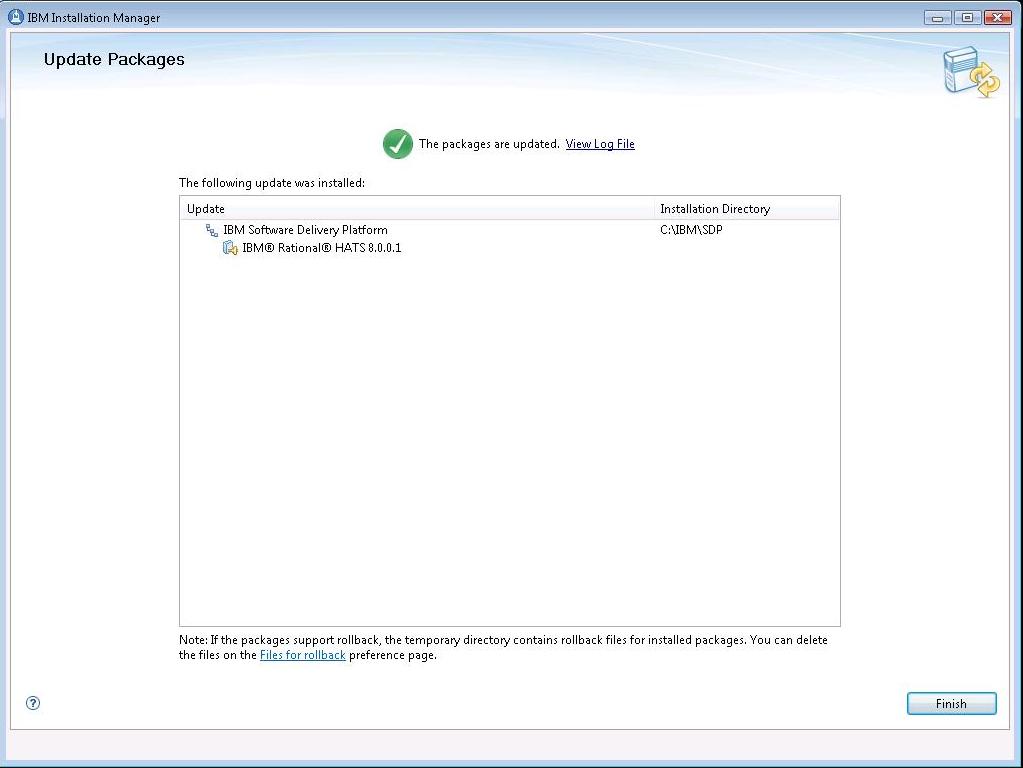
- Exit IBM Installation Manager and start IBM Rational Host Access Transformation Services
from the Windows Start menu to begin using the product. By default this is
under Start > All Programs > IBM Software Delivery Platform >
IBM Rational Host Access Transformation Services.
Ideally, this update should be installed directly from the IBM update server,
as described in the Update
installation instructions section above. However, you may also download an
archive file containing the update and perform local installations. You might
want to do this if:
- You have a slow or unstable Internet connection and want to use a download
manager that can resume the download.
- You have difficulty accessing the live IBM update servers from behind a
firewall.
- You prefer to download the update and install it later.
- Download the HATS_8.0.0.1.zip file from the
download page
to your system. This download page will redirect you to the zip file stored on
IBM's Download Support Portlet known as Fix Central.
- Unzip the HATS_8.0.0.1.zip file to a temporary directory.
- Start IBM Installation Manager from the Windows Start menu. By default
this is under Start > All Programs > IBM Installation Manager >
IBM Installation Manager.
- From the menu bar, select File > Preferences This is where you
will tell the IBM Installation Manager the location of the installation files
you just extracted.
- Click Add Repository in the Preferences dialog.
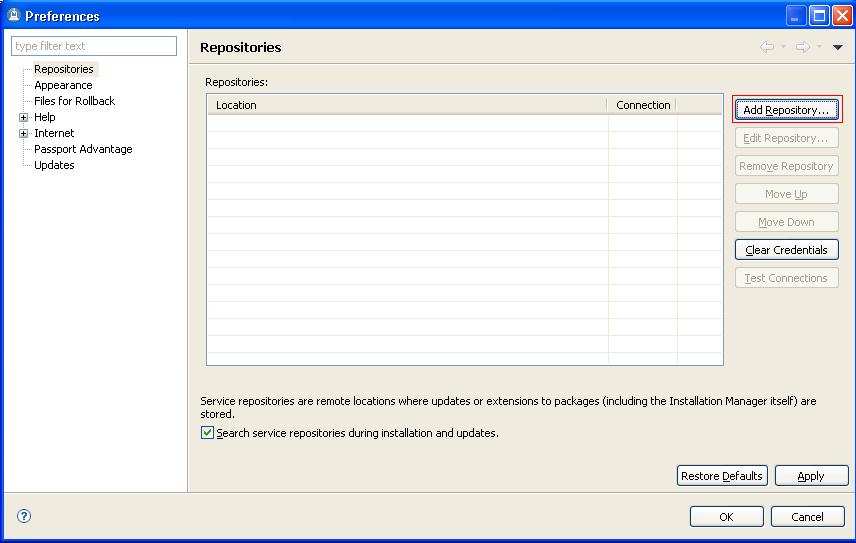
- In the Add Repository panel, click Browse.
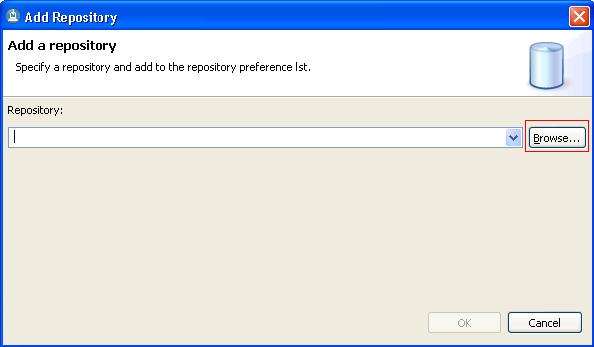
- In the Select a Repository panel, browse to the
directory where you
extracted the update installation files. Inside that directory you will see a
hats\updates folder. Change to that
directory, select repository.config and click Open.
- In the Add Repository panel, click OK.
- Click Test Connections in the Preferences dialog and ensure that the
repository can be found.

- Click OK.
- Now that the local repository has been set, follow the instructions
outlined in the Update installation instructions.
You can verify that the update is installed by running View Installed
Packages which is located on the
Installation Manager menu bar under the File menu. You should see IBM® Rational® HATS_8.0.0.1
listed.
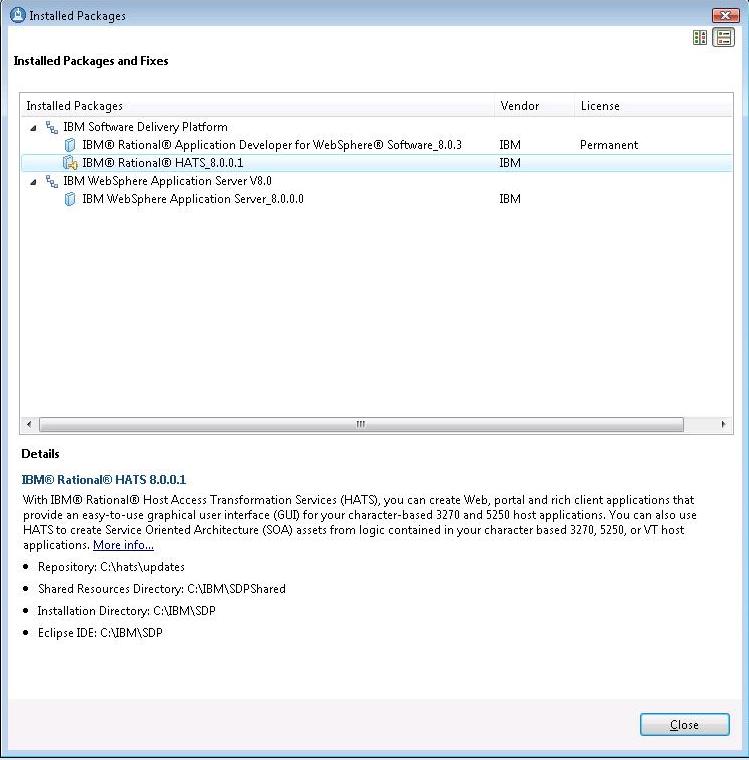
After installing the HATS maintenance and restarting the Rational Toolkit, the HATS projects
in the current workspace are automatically updated with the new files.
HATS project files overwritten by the installation of HATS maintenance are saved.
If HATS maintenance is uninstalled or disabled, HATS projects are
not automatically restored to their former state.
We recommend that you back up your existing HATS projects using a code repository
or export them
as zip files before applying HATS maintenance.
See HATS project updates for more information.
If your workspace contains rich client applications, see
Installing the HATS runtime plug-ins
into your rich client platform for important information.
The project update process creates a backup folder in the project named
save_pre_8.0.0.1.
This folder contains all of the files that were overwritten by the package update process.
These files are saved so that you can compare and merge them with your
newly installed HATS files.
Do not worry if you see errors in the task view; these files are no longer
used by the application.
When you are satisfied that all the saved files have been compared and
merged, you can delete the save_pre_8.0.0.1 folder.
Note:
If you need to roll back to this version of HATS in the future,
the files in this folder are required to perform the roll back.
See Removing installed maintenance
for more information.
After applying a HATS service update, if you have changed the target platform of your
workspace (Window > Preferences > Plug-in Development >Target Platform) from the
default Rational Software Delivery Platform, you are prompted to install the HATS runtime
features and plug-ins into your target platform the first time you start RSDP.
For example, if the target platform of your workspace is Lotus Expeditor, you are prompted
to install the updated HATS runtime plug-ins into this platform.
After the plug-ins are installed, you are prompted to reload the target platform using
the Window > Preferences > Plug-in Development >Target Platform panel.
Applying a service update to a client
To apply a service update to a client that already has a HATS rich client application
installed, follow the instructions in the HATS User's and Administrator's Guide
for
Exporting the HATS runtime features.
This exports the updated versions of the HATS runtime features and plug-ins.
To make these updates available to a client, you can either modify your existing update
site to include the updated features, or you can create a new update site.
See
Creating an update site in the User's and Administrator's Guide
for more information.
Because a HATS service update does not update your rich client projects, there is no
need to re-export or re-install your HATS rich client applications.
If you used the New Product Configuration wizard to create a product package that
includes Eclipse, HATS runtime plug-ins, and its dependencies, you need to regenerate
this package and distribute it to your client machines.
Instructions for creating a new product configuration can be found in the
Packaging an Eclipse client environment for distribution section of the
HATS User's and Administrator's Guide.
There is no automated way to update plug-ins within an Eclipse environment that was
packaged using the steps provided in the HATS User's and Administrator's Guide.
This is a known issue.
You can remove installed HATS maintenance by selecting Roll Back from the
IBM Installation Manager main panel.
Use the rollback feature if you have applied an update to a product package, and decide later
that you want to remove the update and revert to the earlier version of the product.
Installation Manager uninstalls the updated resources, and reinstalls the resources from
the previous version.
When you roll back to a previous version, it is restored with same features
that were associated with the version.
During the rollback process, Installation Manager must access files from the earlier version
of the package.
By default, these files are stored on your system when you install a package.
If you changed the default setting or deleted the files on the Roll Back preferences page,
Installation Manager will require access to your installation repository or media.
If you installed the product from a repository, you must have listed the repository from
which you installed the previous version of the product in your repository preferences
(File > Preferences > Repositories).
To roll
back your installation to a previous version:
- Start IBM Installation Manager from the Windows Start menu. By default
this is under Start > All Programs > IBM Installation Manager >
IBM Installation Manager.
- Click Roll Back.
- Select the package group in which you installed IBM Rational
Host Access Transformation Services. The default is IBM Software Delivery
Platform. The Installed Packages and Fixes list at the bottom of the panel should
show IBM® Rational® Host Access Transformation Services V8.0.0.1 as one of the
installed packages in the package group you selected. Click Next.
- The Roll Back Packages panel will show you the previous versions of Rational
Host Access Transformation Services to which you can roll back. Select the version to which
you would like to roll back. If there are no previous versions listed, you
cannot roll back your installation. If you cannot roll back to a previous version without invalidating your
current configuration, Installation Manager will display an error message at
the top of the Packages panel and you will not be allowed to continue. If you
are unable to roll back your installation, you will need to uninstall the
entire IBM Rational Host Access Transformation Services product in order to uninstall
Fix
Pack V8.0.0.1. If you are able to roll back, click Next.
- Review your selections on the Summary panel. If you want to make any
changes to your selections, click Back and make your changes. When you
are ready to roll back the update, click Roll Back.
When you roll back HATS, HATS projects are not automatically restored to their previous level.
See Manually restoring your workspace for more
information.
Following a roll back of installed HATS maintenance, to manually restore your workspace
to the state before HATS maintenance was installed, follow these steps:
- Shut down Rational Toolkit.
- Restore your HATS projects by copying the files in the save_pre_8.0.0.1
folder back to their original locations.
- Restore your HATS EAR projects:
- Copy RSDP_shared_dir/plugins/com.ibm.hats_8.0.x\product.xml
to the following locations:
- Each HATS EAR project
- Each RCP runtime extension project, if you have rich client applications
- Each HATS web application linked to a WebFacing application for interoperability
Note: The product.xml file must be renamed to hats_product.xml.
where RSDP_shared_dir is the shared directory under the installed RSDP product,
and 8.0.x.x is the version you want to restore.
The default for RSDP_shared_dir is C:\Program Files\IBM\SDPShared.
- Copy the following files from RSDP_shared_dir/plugins to the root of each EAR project,
where 8.0.x.x refers to the target version of the HATS rollback:
- com.ibm.hats.core_8.0.x.x/lib/bidibean.jar
- com.ibm.hats.core_8.0.x.x/lib/hatscommon.jar
- com.ibm.hats.core_8.0.x.x/lib/hatsruntime.jar
- com.ibm.hats.core_8.0.x.x/lib/hodwel.jar
- com.ibm.hats.core_8.0.x.x/lib/ibmjlog.jar
- com.ibm.hats.core_8.0.x.x/lib/HatsService.jar
- com.ibm.hsrendering_8.0.x.x/hsrendering.jar
- com.ibm.eNetwork.beans.HOD_11.x.x.x/habeansnlv2.jar
- com.ibm.etools.iseries.wfcommon_1.x.x.x/runtime/WFCommon.jar
- com.ibm.etools.hasslite_1.0.x.x/hasslite.jar
- com.ibm.hostsim_8.0.0.x/hostsim.jar
- Reset the maintenance flag in the HATS preferences file:
- Edit the RSDP_shared_dir\plugins\com.ibm.hats_8.0.x\product.xml.
Copy the build date to the system clipboard.
The build date is included in the <date> tag under the <build> tag.
- Edit the
workspace_dir\.metadata\.plugins\org.eclipse.core.runtime\.settings\com.ibm.hats.prefs
file, where workspace_dir is your workspace folder.
The default for workspace_dir is
C:\Documents and Settings\user\IBM\rationalsdp\workspace.
Replace the value for the projectBuildDate keyword with the
date you copied from the <date> tag under the
<build> tag in the product.xml file.
- Save the file.
As an alternative to using the graphical installation wizard in IBM Installation Manager,
you can use the command line to install or roll back to a previous HATS version silently.
For more information about installing product updates from a
command line, see Working with silent installations in the IBM
Installation Manager help.
Updates, limitations, and known problems about Host Access
Transformation Services are documented in the form of technotes on the
IBM Software Support web site.
As limitations and problems are discovered and resolved, the
IBM Software Support team updates the knowledge base.
By searching the knowledge base, you can quickly find workarounds or
solutions to problems that you experience.
The following link launches a customized query of the live Support
knowledge base.
To create your own query, go to the
Advanced search
page on the IBM Software Support web site:
View all technotes for Host Access Transformation Services
IBM Software Support provides assistance with product defects.
Before you submit your problem to
IBM Software Support, ensure that your company has an active IBM software
maintenance contract, and that you are authorized to submit problems to
IBM. The type of software maintenance contract that you need depends on
the type of product you have:
-
For IBM distributed software products (including, but not limited to, Tivoli,
Lotus, and Rational products, as well as DB2 and WebSphere products that
run on Windows or UNIX® operating systems), enroll in Passport Advantage
in one of the following ways:
- For IBM eServer software products (including, but not limited to, DB2 and
WebSphere products that run in zSeries, pSeries, and iSeries environments),
you can purchase a software maintenance agreement by working directly with
an IBM sales representative or an IBM Business Partner. For more information
about support for eServer software products, go to the IBM Technical Support
Advantage web site at
http://www.ibm.com/servers/eserver/techsupport.html.
If you are not sure what type of software maintenance contract you need,
call 1-800-IBMSERV (1-800-426-7378) in the United States. From other countries,
go to the "Contacts" page of the IBM Software Support Handbook at
http://www14.software.ibm.com/webapp/set2/sas/f/handbook/contacts.html and click the name of your geographic region for phone numbers of people
who provide support for your location.
To contact IBM Software support, follow these steps:
- Determine the business impact of your problem.
- Describe your problem and gather background information.
- Submit your problem to IBM Software Support.
When you report a problem to IBM, you are asked to supply a severity level.
Therefore, you need to understand and assess the business impact of the
problem that you are reporting. Use the following criteria:
| Severity 1 |
The problem has a critical business impact: You are unable to use the program, resulting in a critical
impact on operations. This condition requires an immediate solution. |
| Severity 2 |
This problem has a significant business impact: The program is usable, but it is severely limited. |
| Severity 3 |
The problem has some business impact: The program is usable, but less significant features
(not critical to operations) are unavailable. |
| Severity 4 |
The problem has minimal business impact: The problem causes little impact on operations, or a
reasonable circumvention to the problem was implemented. |
When describing a problem to IBM, be as specific as possible. Include all
relevant background information so that IBM Software Support specialists
can help you solve the problem efficiently. To save time, know the answers
to these questions:
- What software versions were you running when the problem occurred?
- Do you have logs, traces, and messages that are related to the problem
symptoms? IBM Software Support is likely to ask for this information.
- Can you re-create the problem? If so, what steps do you perform to re-create
the problem?
- Did you make any changes to the system? For example, did you make changes
to the hardware, operating system, networking software, or other system
components?
- Are you currently using a workaround for the problem? If so, please be
prepared to describe the workaround when you report the problem.
You can submit your problem to IBM Software Support in one of two ways:
If the problem you submit is for a software defect or for missing or inaccurate
documentation, IBM Software Support creates an Authorized Program Analysis
Report (APAR). The APAR describes the problem in detail. Whenever possible,
IBM Software Support provides a workaround that you can implement until
the APAR is resolved and a fix is delivered. IBM publishes resolved APARs
on the Software Support web site daily, so that other users who experience
the same problem can benefit from the same resolution.
Trademarks
IBM, the IBM logo, and ibm.com are trademarks or
registered trademarks of International Business Machines Corp., registered in
many jurisdictions worldwide. Other product and service names might be
trademarks of IBM or other companies. A current
list of IBM trademarks is available on the web at "Copyright and trademark
information" at www.ibm.com/legal/copytrade.shtml.
Linux is a registered trademark of Linus Torvalds in the United States, other countries, or both.
Microsoft and Windows are trademarks
of Microsoft Corporation in the United States, other countries, or both.
UNIX is a registered trademark of The Open Group in the United States and other countries.
Java and all Java-based trademarks and logos are trademarks or registered
trademarks of Oracle and/or its affiliates.
Other product and service names might be trademarks of IBM or other
companies.









